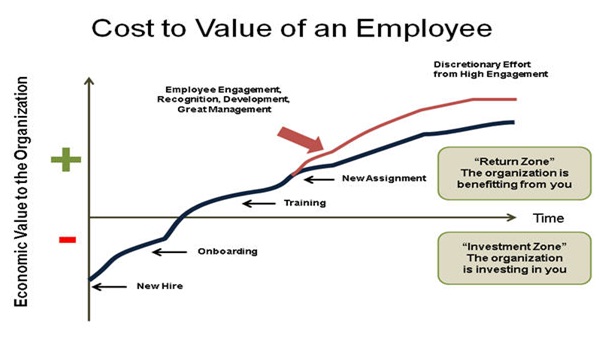Employee Retention
Companies show that “employee retention” has become a vast issue. Some research-based perspectives on this critically important topic.
Retention Meaning:
All companies measure turnover. In industries (retail, customer service, hospitality) turnover rates of 30-40% are common and sometimes even accepted. One HR manager always design organization around high-turnover: HR Manager sure jobs are easy to learn so we can rapidly assimilate new people.
The fact of is in many companies research facts and truth which shows that it is not a sound strategy.
Costing value of an employee
• Hiring a new person (advertising, interviewing, screening, recruiting, selection)
• Cost of on boarding a new person (training, management time)
• productivity Count (a new person may take 1-2 years to reach the productivity of an existing person)
• Lost engagement (other employees who see high turnover disengage and lose productivity)
• Customer service and errors (new employees take longer and are often less adept at solving problems). In healthcare this may result in much higher error rates, illness, and other very expensive costs (which are not seen by HR)
• Training cost (over 2-3 years you likely invest 10-20% of an employee’s salary or more in training, that is gone)
• Cultural impact (whenever someone leaves others take time to ask “why?”).And most importantly of all, we have to remember that people are what we call an “appreciating asset.” The longer we stay with an organization the more productive we get – we learn the systems, we learn the products, and we learn how to work together.
Employees over Time Economic Value
Consider the following simple chart. It simply shows that initially most employees are a “cost” to the organization, and that over time, with the right talent practices, they become more and more valuable. Our job in HR is to attract the “right people” and move them up this curve as rapidly and effectively as possible.

Fig 1: Economic Value of an Employee to the Organization over Time (C) Bersin by Deloitte
Earlier Days HR manager feel somewhat unproductive and often search for ways to add more value. But in the work environment (onboarding, coaching, training, teamwork) we rapidly “find our place” and start putting efforts and added more values by employees
Talent “System”
Retention has become an important issue for many reasons. The economy is picking up; young employees want more career growth and development; the work environment in companies has not kept up with the outside world; management doesn’t always understand how to motivate younger people; and in developing economies the workforce is simply in great demand and the competition for talent is fierce. Added to this, of course, tools like job portal now make it easier than ever for you to look for a new job (or get poached).
And we know that high-performing companies have loyal employees.. One of the most important studies on this was done by Harvard many years ago and it proves that only by making your employees happy can you ultimately make your customers happy.
Other research by Wayne Cascio called “Lay off the Layoffs” similarly shows that companies that push layoffs on their employees create long term problems which often take years to fix. The reason? Layoffs, like retention problems, create low levels of employee commitment which in turn move employees back down the value curve. Covey’s wonderful book “The Speed of Trust” clearly explains this in ways that leaders can understand.
Bersin by Deloitte
https://www.linkedin.com
Fix up the issue:
We find so many things but over the years employees blames them first line management “people don’t leave companies they leave managers.” Obvious there is much truth to this – nobody wants to work for difficult manager. But research shows that the real “retention model” in companies is far more complex.
Look at retention model (Deloitte has both a “retention diagnostic” as well as a “retention analytics” model) they find that each company has its own unique “retention model.”
Typically the model involves a whole variety of factors versatileness, and these factors take on different weights depending on the age, demographic, and role of the employee. So your goal is not to simply do one thing, but to understand your own company’s “retention drivers” by role. Bersin by Deloitte
Some of the interesting things to consider:
• Wedges, salary, compensation, remuneration plays a vital role, but not as much as we think. Little money will definitely create high churn, but over compensating people won’t make up for a poor work culture
Job fit is critically important. In fact there is a “job value proposition.” if attracted the “right people” for each job” Some jobs are particularly demanding If you honestly explain these roles and their positives and negatives you will attract people that “fit.”
• Growth in career: in current scenarios of the companies are going through a “crew shift” as younger generation employees retire and millennial and young people enter management and high value positions. Younger folks are motivated by growth, career opportunity, and meaning. Research shows that young people want the same types of benefits and work-life balance as older people; they are particularly focused on fun, collaboration, and the ability to be with others they enjoy. So the prospect of a “career” is more than just advancement
• Work culture matters. On recognition, engagement, leadership, and management. It all shows clearly that people at work respond through Maslow’s Hierarchy of Needs. Once they are “safe” they think for so many things. I.e. skills, proud for own work.
These “non-compensation” and “non-job” factors are bigger than ever now. All facts show that we have to think about “system” which engages employees.
Ultimately the most successful and enduring organizations in business are those that have a common sense of mission, a deep respect for their employees (and customers of course), and put time, energy, and money into building a highly engaging environment. They carefully select the “right people” with lots of hard work, and once people join they take the time to make sure they have development opportunities to move up the value curve.
“Retention” may be no more than a symptom, but it’s something you should take seriously. In today’s heating economy and rapid shift in demographics, you’ll be competing for talent regardless of your industry
